Neural Networks for Prediction of 3D Printing Parameters for Reducing Particulate Matter Emissions and Enhancing Sustainability
Abstract
1. Introduction
1.1. Types of Technologies in 3D Printing
- Fused Deposition Modeling (FDM): this popular technique involves melting plastic and layering it to build objects;
- Stereolithography (SLA): uses UV light to cure resin layer by layer, allowing for highly detailed prints;
- Selective Laser Sintering (SLS): employs a laser to melt or sinter plastic, metal, or ceramic powders layer by layer;
- Digital Light Processing (DLP): similar to SLA, this method uses UV light to cure resin but employs a projector for faster printing;
- Binder Jetting: applies a binder to a layer of powder, which is then cured to form the object, built up layer by layer;
- Electron Beam Melting (EBM): uses an electron beam to melt and fuse metal powders, creating strong, durable objects;
- Laminated Object Manufacturing (LOM): involves stacking, cutting, and gluing layers of material, such as paper or plastic, to form a 3D object.
1.2. Types of FDM 3D Printing Emissions
1.3. Aim of the Study
2. Materials and Methods
2.1. Data Set
- Experiment number—a unique identifier for each series of experiments;
- Manufacturer, material, and color—information about the filament used in the printing process;
- Moisture content of the filament and age of the filament—parameters affecting print quality and particle emissions;
- Printer, construction, and class—details of the printing equipment used;
- Printing time, humidity, and temperature—environmental conditions during printing;
- PM 1.0, PM 2.5, and PM 10.0 concentrations—results of particle emission measurements in different ranges per unit time, measured by two independent sensors.
- Cfinal is the final concentration value at the end of the 1-min interval, and
- Cinitial is the initial concentration value at the start of the 1-min interval.
2.2. Analysis of Measurement Data
2.3. Computationalmethods
3. Results
4. Discussion
4.1. Limitations of Previous Studies
4.2. Directions for Further Studies
5. Conclusions
Supplementary Materials
Author Contributions
Funding
Institutional Review Board Statement
Informed Consent Statement
Data Availability Statement
Conflicts of Interest
References
- Campbell, I.; Bourell, D.; Gibson, I. Additive manufacturing: Rapid prototyping comes of age. Rapid Prototyp. J. 2012, 18, 255–258. [Google Scholar] [CrossRef]
- Gibson, I.; Rosen, D.W.; Stucker, B. Additive Manufacturing Technologies: 3D Printing, Rapid Prototyping, and Direct Digital Manufacturing; Springer: New York, NY, USA, 2014. [Google Scholar]
- Karayannis, P.; Petrakli, F.; Gkika, A.; Koumoulos, E. 3D-Printed Lab-on-a-Chip Diagnostic Systems—Developing a Safe-by-Design Manufacturing Approach. Micromachines 2019, 10, 825. [Google Scholar] [CrossRef] [PubMed]
- Saadi, M.A.S.R.; Maguire, A.; Pottackal, N.T.; Thakur, M.S.H.; Ikram, M.M.; Hart, A.J.; Ajayan, P.M.; Rahman, M.M. Direct ink writing: A 3D printing technology for diverse materials. Adv. Mater. 2022, 34, 2108855. [Google Scholar] [CrossRef]
- Siemiński, P.; Budzik, G. Techniki Przyrostowe. Druk, Drukarki 3D; Politechnika Warszawska: Warszawa, Poland, 2015; pp. 11–145. [Google Scholar]
- Bravia, L.; Murmura, F.; Santos, G. Additive Manufacturing: Possible Problems with Indoor Air Quality. Procedia Manuf. 2019, 41, 952–959. [Google Scholar] [CrossRef]
- Khaki, S.; Rio, M.; Marin, P. Monitoring Indoor Air Quality in Additive Manufacturing Environments. Procedia CIRP 2020, 90, 455–460. [Google Scholar] [CrossRef]
- Stabile, L.; Scungio, M.; Buonanno, G.; Arpino, F.; Ficco, G. Airborne Particle Emission of a Commercial 3D Printer: The Effect of Filament Material and Printing Temperature. Indoor Air 2016, 27, 398–408. [Google Scholar] [CrossRef] [PubMed]
- Azimi, P.; Zhao, D.; Pouzet, C.; Crain, N.E.; Stephens, B. Emissions of Ultrafine Particles and Volatile Organic Compounds from Commercially Available Desktop Three-Dimensional Printers with Multiple Filaments. Environ. Sci. Technol. 2016, 50, 1260–1268. [Google Scholar] [CrossRef]
- Gu, J.; Wensing, M.; Uhde, E.; Salthammer, T. Characterization of Particulate and Gaseous Pollutants Emitted during Operation of a Desktop 3D Printer. Environ. Int. 2019, 123, 476–485. [Google Scholar] [CrossRef]
- Stefaniak, A.B.; Le Bouf, R.F.; Yi, J.; Ham, J.; Nurkewicz, T.; Schwegler-Berry, D.E.; Chen, B.T.; Wells, J.R.; Duling, M.G.; Lawrence, R.B.; et al. Characterization of Chemical Contaminants Generated by a Desktop Fused Deposition Modeling 3-Dimensional Printer. J. Occup. Environ. Hyg. 2017, 14, 540–550. [Google Scholar] [CrossRef]
- Schönberger, R.; Bernau, M.; Lüllmann, H.; Janhäll, S.; Heringa, M.; Kim, Y.-S.; Li, D.; Geyer, H.; Göbel, J.; Möller, W. Emissions of Volatile Organic Compounds and Particulate Matter from Fused Deposition Modeling 3D Printers: Analysis and Exposure Assessment. Environ. Sci. Technol. 2021, 55, 8747–8755. [Google Scholar]
- Ntziachristos, L.; Drossinos, Y.; Crounse, J.D.; Elshout, R.; Weichenthal, S.; O’Neill, M.S.; Donahue, N.M. Particulate Matter Emissions from 3D Printing: A Study of the Contribution of Different Print Materials and Operating Conditions. J. Hazard. Mater. 2022, 423, 127257. [Google Scholar] [CrossRef]
- Misztal, T.J.; Addasi, O.; Albano, J.; Liu, Y. An Experimental Study on the Emission Dynamics in Fused Deposition Modelling (FDM) 3D Printing Process. In Proceedings of the Fluids Engineering Division Summer Meeting, Anaheim, CA, USA, 15–17 July 2024; Volume 88124, p. V001T01A021. [Google Scholar]
- Zhang, Q.; Wong, J.; Davis, A.; Black, M.; Weber, R. Characterization of Particle Emissions from Consumer Fused Deposition Modeling 3D Printers. Aerosol Sci. Technol. 2017, 51, 1275–1286. [Google Scholar] [CrossRef]
- Viitanen, A.; Kallonen, K.; Kukko, K.; Kanerva, T.; Saukko, E.; Hussein, T.; Hameri, K.; Saamanen, A. Technical Control of Nanoparticle Emissions from Desktop 3D Printing. Indoor Air 2021, 31, 1061–1071. [Google Scholar] [CrossRef] [PubMed]
- Min, K.; Li, Y.; Wang, D.; Chen, B.; Ma, M.; Hu, L.; Liu, Q.; Jiang, G. 3D Printing-Induced Fine Particle and Volatile Organic Compound Emission: An Emerging Health Risk. Environ. Sci. Technol. Lett. 2021, 8, 616–625. [Google Scholar] [CrossRef]
- Zhang, Q.; Pardo, M.; Rudich, Y.; Kaplan-Ashiri, I.; Wong, J.P.S.; Davis, A.Y.; Black, M.S.; Weber, R.J. Chemical Composition and Toxicity of Particles Emitted from a Consumer-Level 3D Printer Using Various Materials. Environ. Sci. Technol. 2019, 53, 12054–12061. [Google Scholar] [CrossRef]
- Lee, S.; Park, H.; Kim, H.; Lim, H.; Hwang, H.; Ryu, J.; Lee, J.; Kim, Y.; Jeong, J.; Park, S. Emission Characteristics and Health Risks of Particulate Matter and Volatile Organic Compounds from Fused Deposition Modeling 3D Printers with Various Filament Types. Environ. Sci. Technol. 2023, 57, 1550–1560. [Google Scholar]
- Yang, Y.; Xu, Z.; Zhang, X.; Wang, J.; Chen, L.; Shi, J.; Zheng, X.; Liu, S. Investigation of Particle and Gas Emissions from 3D Printers: Impacts of Printing Materials and Conditionson Air Quality. J. Hazard. Mater. 2023, 448, 131169. [Google Scholar]
- Wang, S.; Chen, Y.; Li, X.; Zhang, Y.; Xu, X.; Zhang, L. Recent Advances in Understanding the Health Impacts of Fine Particulate Matter (PM2.5) Exposure. Sci. Total Environ. 2020, 730, 139154. [Google Scholar] [CrossRef]
- Zhao, B.; Chen, R.; Kan, H.; Huang, W.; Xu, X.; Bai, Z. The Impact of Fine Particulate Matter (PM2.5) on Health: A Review of Recent Research. Environ. Pollut. 2021, 276, 116673. [Google Scholar] [CrossRef]
- Jiang, Y.; Li, Z.; Lin, H.; Zhang, J.; Zhang, M.; Liu, W. Fine Particulate Matter (PM2.5) and Cardiovascular Health: A Review of Current Evidence and Future Directions. Int. J. Environ. Res. Public Health 2022, 19, 2221. [Google Scholar] [CrossRef]
- Khaki, S.; Duffy, E.; Smetaon, A.F.; Morrin, A. Monitoring of particulate matter emissions from 3D printing activity in the homesetting. Sensors 2021, 21, 3247. [Google Scholar] [CrossRef] [PubMed]
- Ding, S.; Wan, M.P.; Ng, B.F. Dynamic analysis of particle emissions from FDM 3D printers through a comparative study of chamber and flow tunnel measurements. Environ. Sci. Technol. 2020, 54, 14568–14577. [Google Scholar] [CrossRef] [PubMed]
- Park, J.; Kwon, O.H.; Yoon, C.; Park, M. Estimates of particulate matter inhalation doses during three-dimensional printing: How many particles can penetrate into our body? Indoor Air 2021, 31, 392–404. [Google Scholar] [CrossRef] [PubMed]
- Zhang, J.; Chen, D.R.; Chen, S.C. A review of emission characteristics and control strategies for particles emitted from 3D fused deposition modeling (FDM) printing. Build. Environ. 2022, 221, 109348. [Google Scholar] [CrossRef]
- O’Connell, S.; Smith, G.; Jonnalagadda, S.; Wensel, S. The Use and Applications of 3D Printing Materials: A Survey. J. Manuf. Process. 2021, 64, 431–442. [Google Scholar] [CrossRef]
- Jang, J.; Ko, K.; Kim, S.; Kim, K.; Song, J. A Review of 3D Printing Technologies for Industrial Applications. Adv. Mater. Sci. Eng. 2020, 2020, 6018401. [Google Scholar]
- Zhang, Q.; Zhou, Y.; Zou, S. Convergence Guarantees for RMSProp and Adamin Generalized-smooth Non-convex Optimization with Affine Noise Variance. arXiv 2024, arXiv:2404.01436. [Google Scholar]
- Kwesi Wayo, D.D.; Irawan, S.; Satyanaga, A.; Kim, J. Data-Driven Fracture Morphology Prognosis from High Pressured Modified Proppants Based on Stochastic-Adam-RMSprop Optimizers; tf. NNR Study. Big Data Cogn. Comput. 2023, 7, 57. [Google Scholar] [CrossRef]
- Zou, F.; Shen, L.; Jie, Z.; Zhang, W.; Liu, W. A Sufficient Condition for Convergences of Adam and RMSProp. In Proceedings of the IEEE/CVF Conference on Computer Vision and Pattern Recognition (CVPR), LongBeach, CA, USA, 15–20 June 2019; pp. 11127–11135. [Google Scholar]
- Martini, B.; Bellisario, D.; Coletti, P. Human-Centered and Sustainable Artificial Intelligence in Industry 5.0: Challenges and Perspectives. Sustainability 2024, 16, 5448. [Google Scholar] [CrossRef]
- Rani, S.; Jining, D.; Shoukat, K.; Shoukat, M.U.; Nawaz, S.A. A Human–Machine Interaction Mechanism: Additive Manufacturing for Industry 5.0—Design and Management. Sustainability 2024, 16, 4158. [Google Scholar] [CrossRef]
- Abubakr, M.; Abbas, A.T.; Tomaz, I.; Soliman, M.S.; Luqman, M.; Hegab, H. Sustainable and Smart Manufacturing: An Integrated Approach. Sustainability 2020, 12, 2280. [Google Scholar] [CrossRef]
- Nahavandi, S. Industry 5.0—A Human-Centric Solution. Sustainability 2019, 11, 4371. [Google Scholar] [CrossRef]
- Zhou, L.; Miller, J.; Vezza, J.; Mayster, M.; Raffay, M.; Justice, Q.; Al Tamimi, Z.; Hansotte, G.; Sunkara, L.D.; Bernat, J. Additive Manufacturing: A Comprehensive Review. Sensors 2024, 24, 2668. [Google Scholar] [CrossRef] [PubMed]
- Rojek, I.; Mikołajewski, D.; Dostatni, E.; Kopowski, J. Specificity of 3D Printing and AI-Based Optimization of Medical Devices Using the Example of a Group of Exoskeletons. Appl. Sci. 2023, 13, 1060. [Google Scholar] [CrossRef]
- Vahed, R.; Zareie Rajani, H.R.; Milani, A.S. Can a Black-Box AI Replace Costly DMA Testing?—A Case Study on Prediction and Optimization of Dynamic Mechanical Properties of 3D Printed Acrylonitrile Butadiene Styrene. Materials 2022, 15, 2855. [Google Scholar] [CrossRef]
- Rehman, S.U.; Riaz, R.D.; Usman, M.; Kim, I.-H. Augmented Data-Driven Approach towards 3D Printed Concrete Mix Prediction. Appl. Sci. 2024, 14, 7231. [Google Scholar] [CrossRef]
- Bohušík, M.; Stenchlák, V.; Císar, M.; Bulej, V.; Kuric, I.; Dodok, T.; Bencel, A. Mechatronic Device Control by Artificial Intelligence. Sensors 2023, 23, 5872. [Google Scholar] [CrossRef]
- Huang, Z.; Shen, Y.; Li, J.; Fey, M.; Brecher, C. A Survey on AI-Driven Digital Twins in Industry 4.0: Smart Manufacturing and Advanced Robotics. Sensors 2021, 21, 6340. [Google Scholar] [CrossRef]
- Rojek, I.; Dostatni, E.; Mikołajewski, D.; Pawłowski, L.; Wegrzyn-Wolska, K. Modern approach to sustainable production in the context of Industry 4.0. Bull. Pol. Acad. Sci. Tech. Sci. 2022, 70, e143828. [Google Scholar] [CrossRef]
- Păvăloaia, V.-D.; Necula, S.-C. Artificial Intelligence as a Disruptive Technology—A Systematic Literature Review. Electronics 2023, 12, 1102. [Google Scholar] [CrossRef]
- See, A.R.; Advincula, W.D. Creating Tactile Educational Materials for the Visually Impaired and Blind Students Using AI Cloud Computing. Appl. Sci. 2021, 11, 7552. [Google Scholar] [CrossRef]
- Pazienza, A.; Monte, D. Introducing the Monitoring Equipment Mask Environment. Sensors 2022, 22, 6365. [Google Scholar] [CrossRef] [PubMed]
- Rojek, I. Models for Better Environmental Intelligent Management within Water Supply Systems. Water Resour. Manag. 2014, 28, 3875–3890. [Google Scholar] [CrossRef]
- Živković, M.; Žujović, M.; Milošević, J. Architectural 3D-Printed Structures Created Using Artificial Intelligence: A Review of Techniques and Applications. Appl. Sci. 2023, 13, 10671. [Google Scholar] [CrossRef]
- Zylka, L.; Burek, J.; Mazur, D. Diagnostic of peripheral longitudinal grinding by using acoustic emissionsignal. Adv. Prod. Eng. Manag. 2017, 12, 221–232. [Google Scholar]
- Li, C.; Bian, S.; Wu, T.; Donovan, R.P.; Li, B. Affordable Artificial Intelligence-Assisted Machine Supervision System for the Small and Medium-Sized Manufacturers. Sensors 2022, 22, 6246. [Google Scholar] [CrossRef]
- Rojek, I. Neural networks as prediction models for water intake in water supply system. In Artificial Intelligence and Soft Computing—ICAISC 2008; Lecture Notes in Computer Science; Rutkowski, L., Tadeusiewicz, R., Zadeh, L.A., Zurada, J.M., Eds.; Springer: Berlin/Heidelberg, Germany, 2008; Volume 5097, pp. 1109–1119. [Google Scholar]
- Gašparovič, M.; Jungová, P.; Tomášik, J.; Mriňáková, B.; Hirjak, D.; Timková, S.; Danišovič, Ľ.; Janek, M.; Bača, Ľ.; Peciar, P.; et al. Evolving Strategies and Materials for Scaffold Development in Regenerative Dentistry. Appl. Sci. 2024, 14, 2270. [Google Scholar] [CrossRef]
- Lubkowski, P.; Krygier, J.; Sondej, T.; Dobrowolski, A.P.; Apiecionek, L.; Znaniecki, W.; Oskwarek, P. Decision Support System Proposal for Medical Evacuations in Military Operations. Sensors 2023, 23, 5144. [Google Scholar] [CrossRef]
- Kaščák, Ľ.; Varga, J.; Bidulská, J.; Bidulský, R. Simulation of 316L Stainless Steel Produced the Laser Powder Bed Fusion Process. Materials 2023, 16, 7653. [Google Scholar] [CrossRef]
- Kaščák, Ľ.; Varga, J.; Bidulská, J.; Bidulský, R.; Manfredi, D. Weight Factor as a Parameter for Optimal Part Orientation in the L-PBF Printing Process Using Numerical Simulation. Materials 2024, 17, 3604. [Google Scholar] [CrossRef]
- Han, H.R. Hybrid Fiber Materials according to the Manufacturing Technology Methods and IOT Materials: A Systematic Review. Materials 2023, 16, 1351. [Google Scholar] [CrossRef] [PubMed]
- Jekateryńczuk, G.; Piotrowski, Z. A Survey of Sound Source Localization and Detection Methods and Their Applications. Sensors 2024, 24, 68. [Google Scholar] [CrossRef] [PubMed]
- Rojek, I.; Jagodziński, M. Hybrid Artificial Intelligence System in Constraint Based Scheduling of Integrated Manufacturing ERP Systems. In Hybrid Artificial Intelligent Systems; Lecture Notes in Computer Science; Corchado, E., Snášel, V., Abraham, A., Woźniak, M., Graña, M., Cho, S.B., Eds.; Springer: Berlin/Heidelberg, Germany, 2012; Volume 7209, pp. 229–240. [Google Scholar]
- Krajewski, D.; Oleksy, M.; Oliwa, R.; Bulanda, K.; Czech, K.; Mazur, D.; Masłowski, G. Methods for Enhancing the Electrical Properties of Epoxy Matrix Composites. Energies 2022, 15, 4562. [Google Scholar] [CrossRef]
- Martinek, R.; Ladrova, M.; Sidikova, M.; Jaros, R.; Behbehani, K.; Kahankova, R.; Kawala-Sterniuk, A. Advanced Bioelectrical Signal Processing Methods: Past, Present, and Future Approach—Part III: Other Biosignals. Sensors 2021, 21, 6064. [Google Scholar] [CrossRef]
- Režek Jambrak, A.; Nutrizio, M.; Djekić, I.; Pleslić, S.; Chemat, F. Internet of Nonthermal Food Processing Technologies (IoNTP): Food Industry 4.0 and Sustainability. Appl. Sci. 2021, 11, 686. [Google Scholar] [CrossRef]
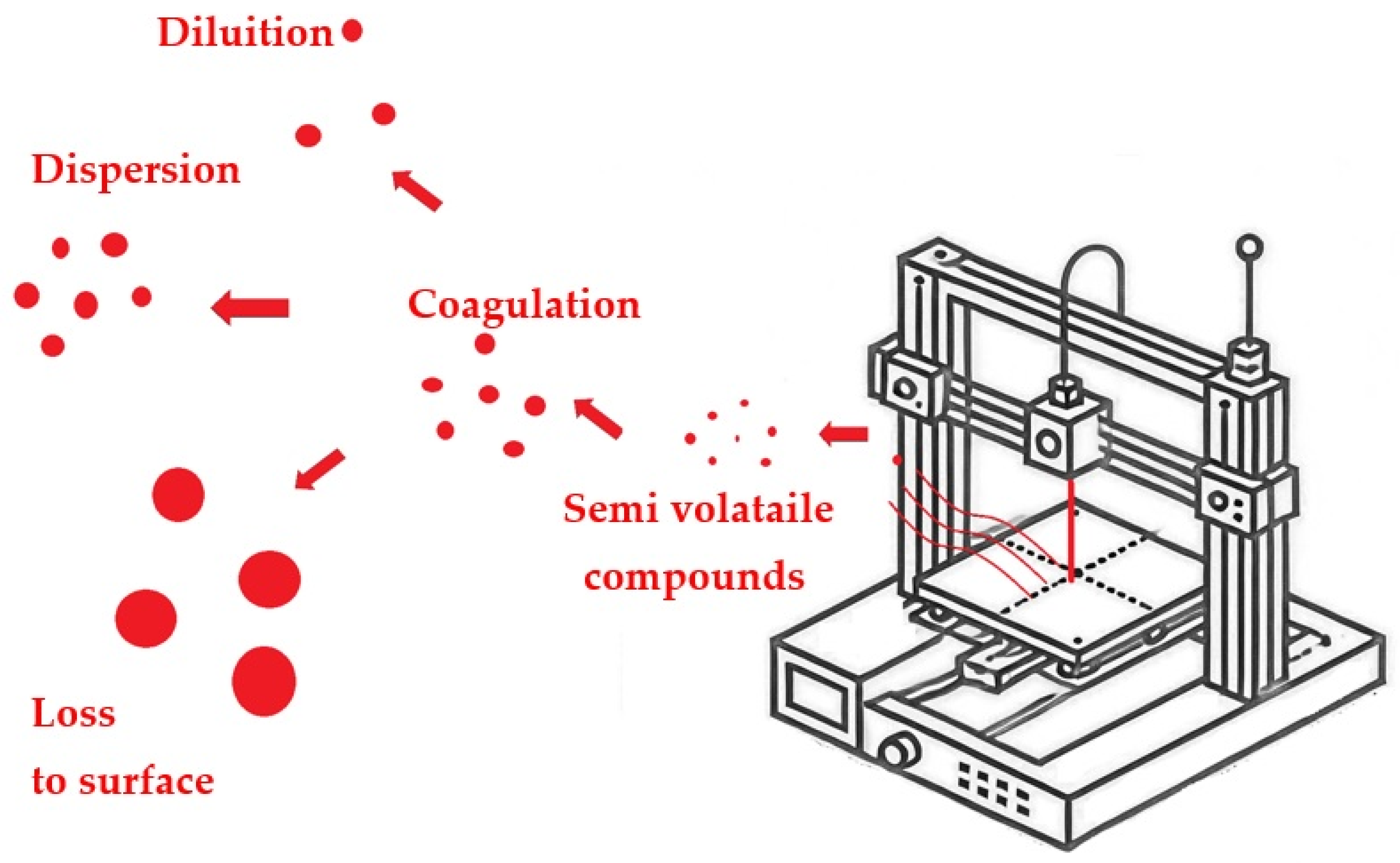
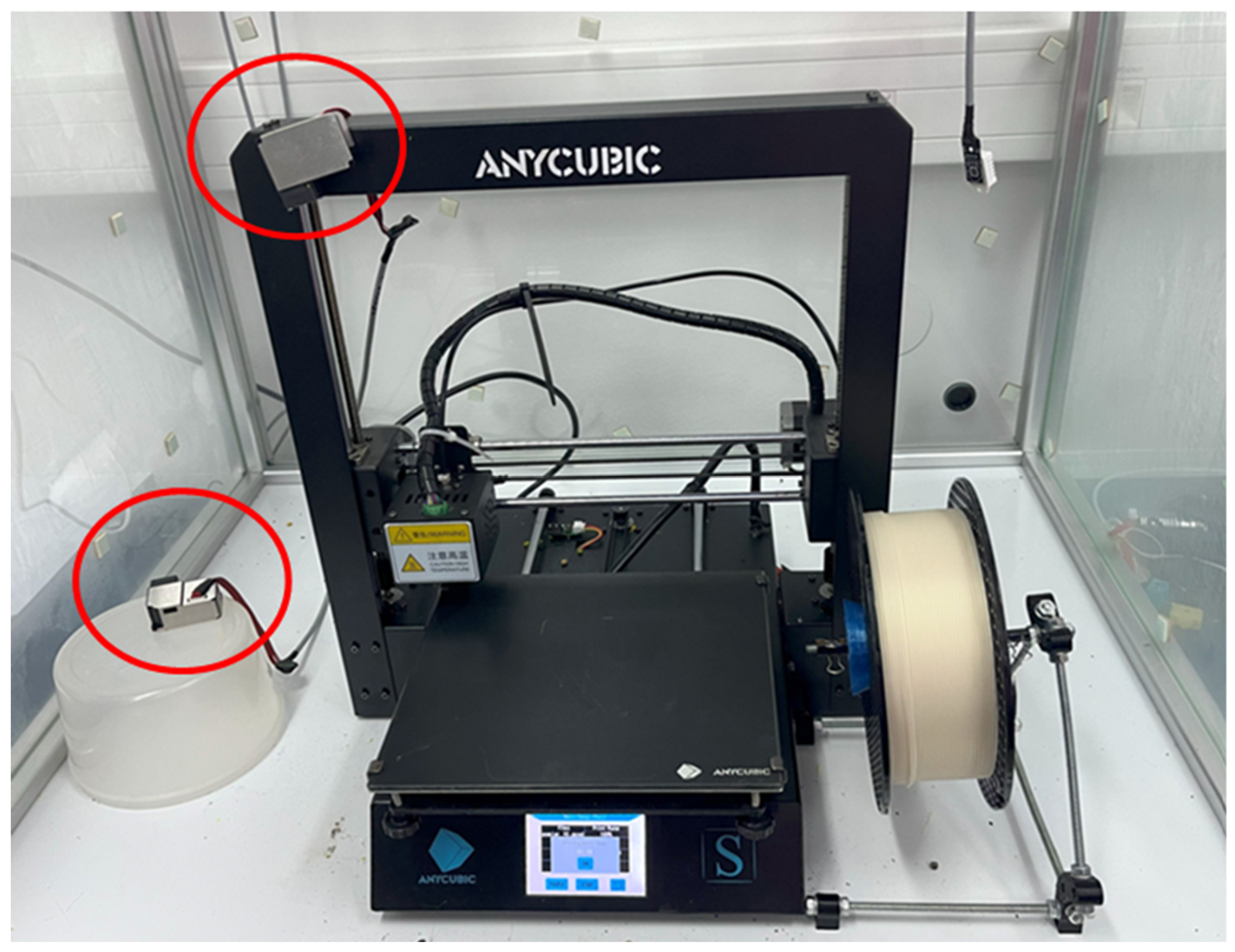
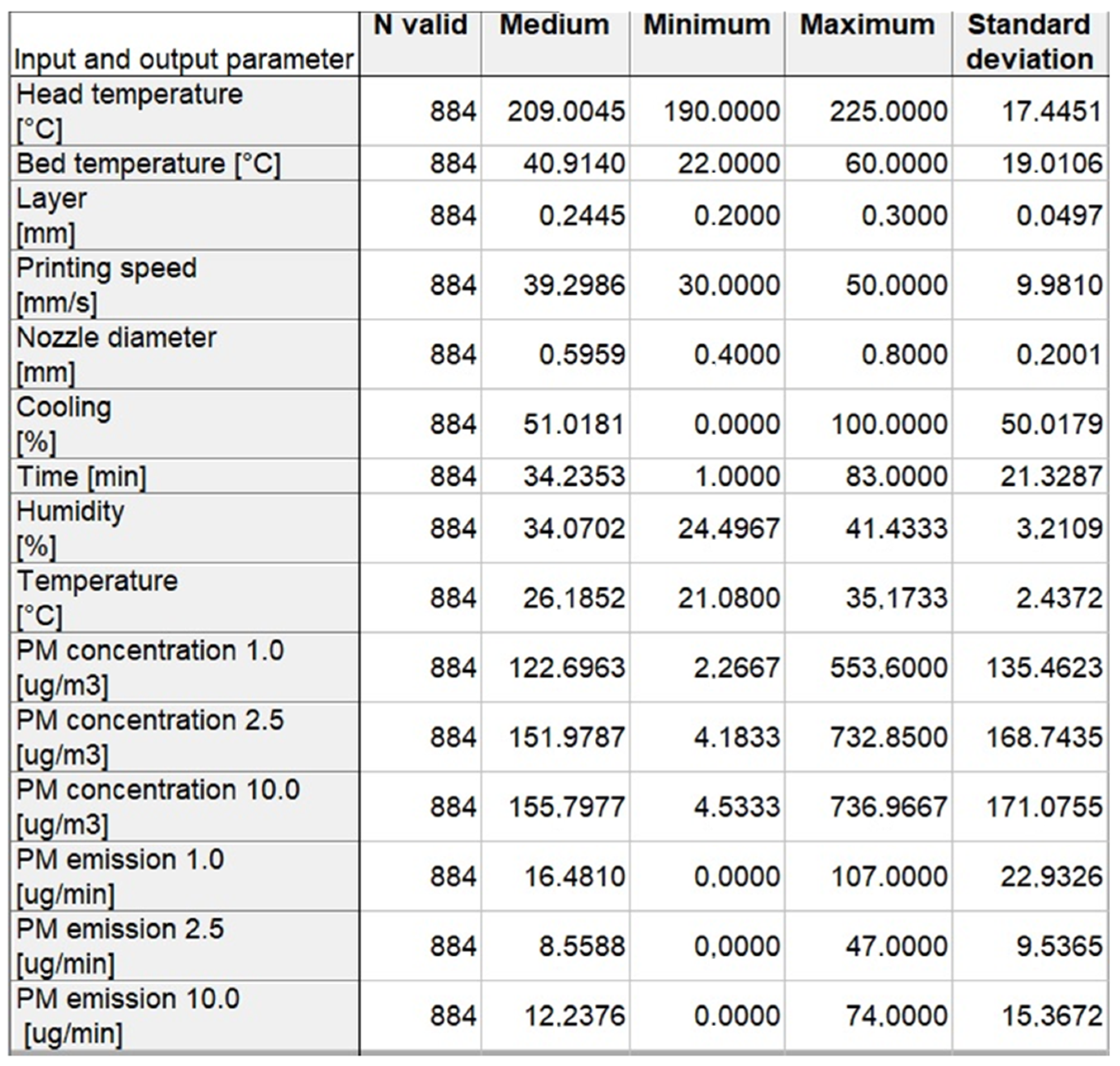
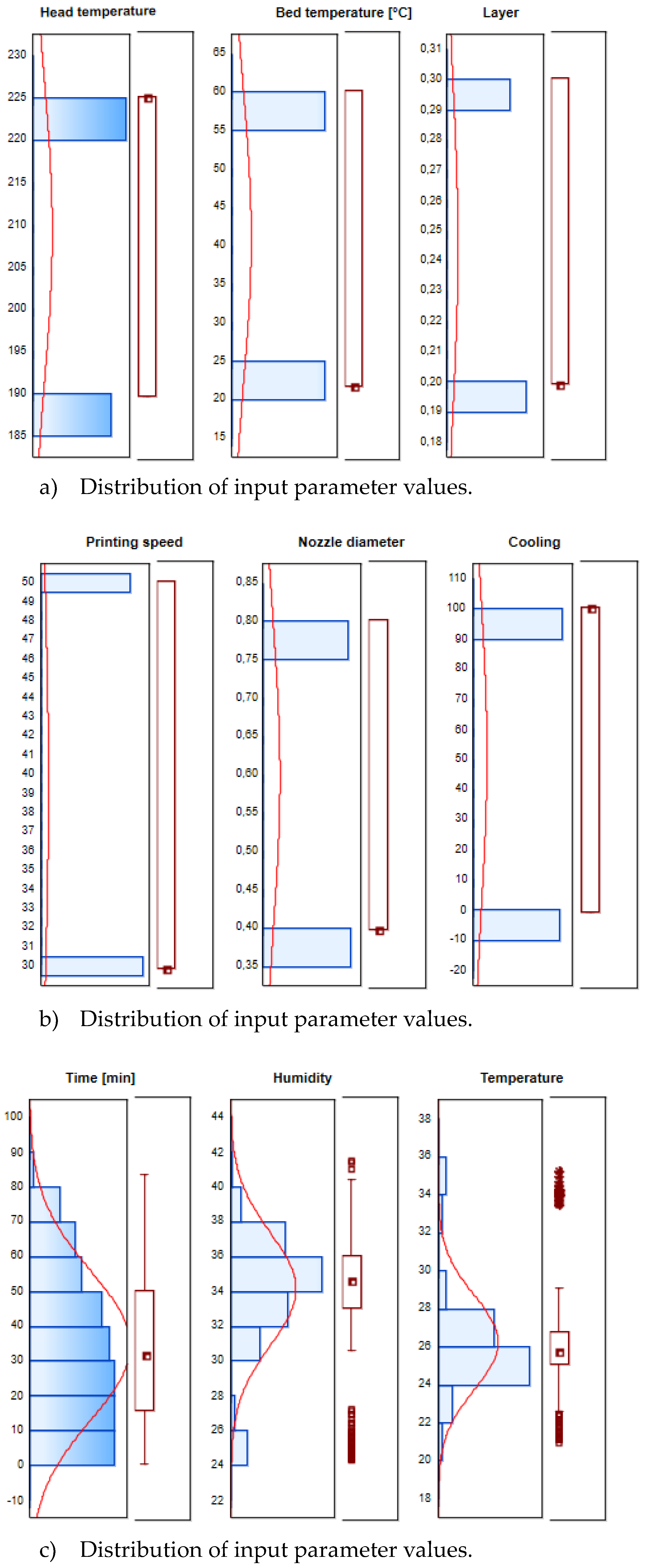
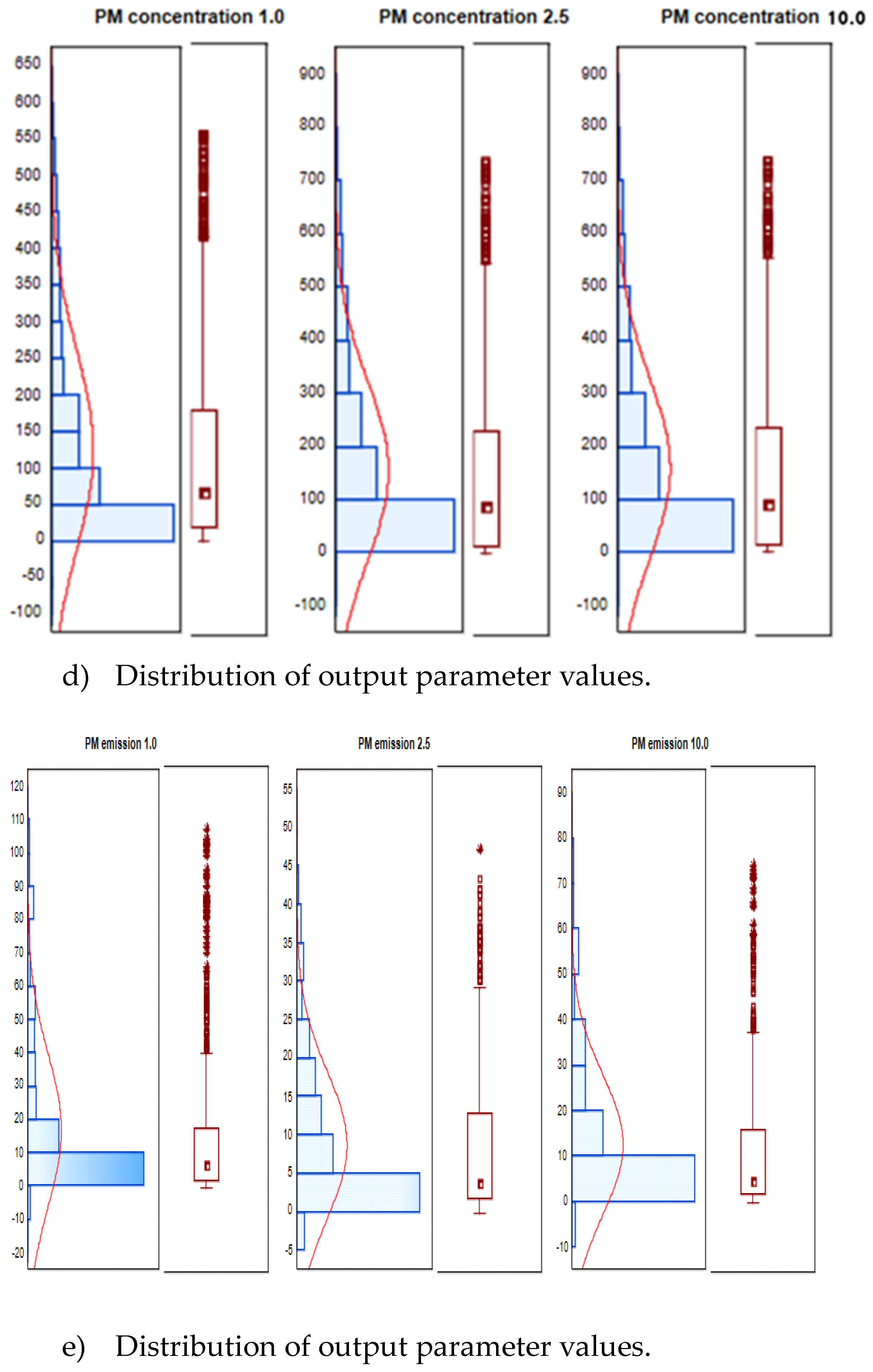

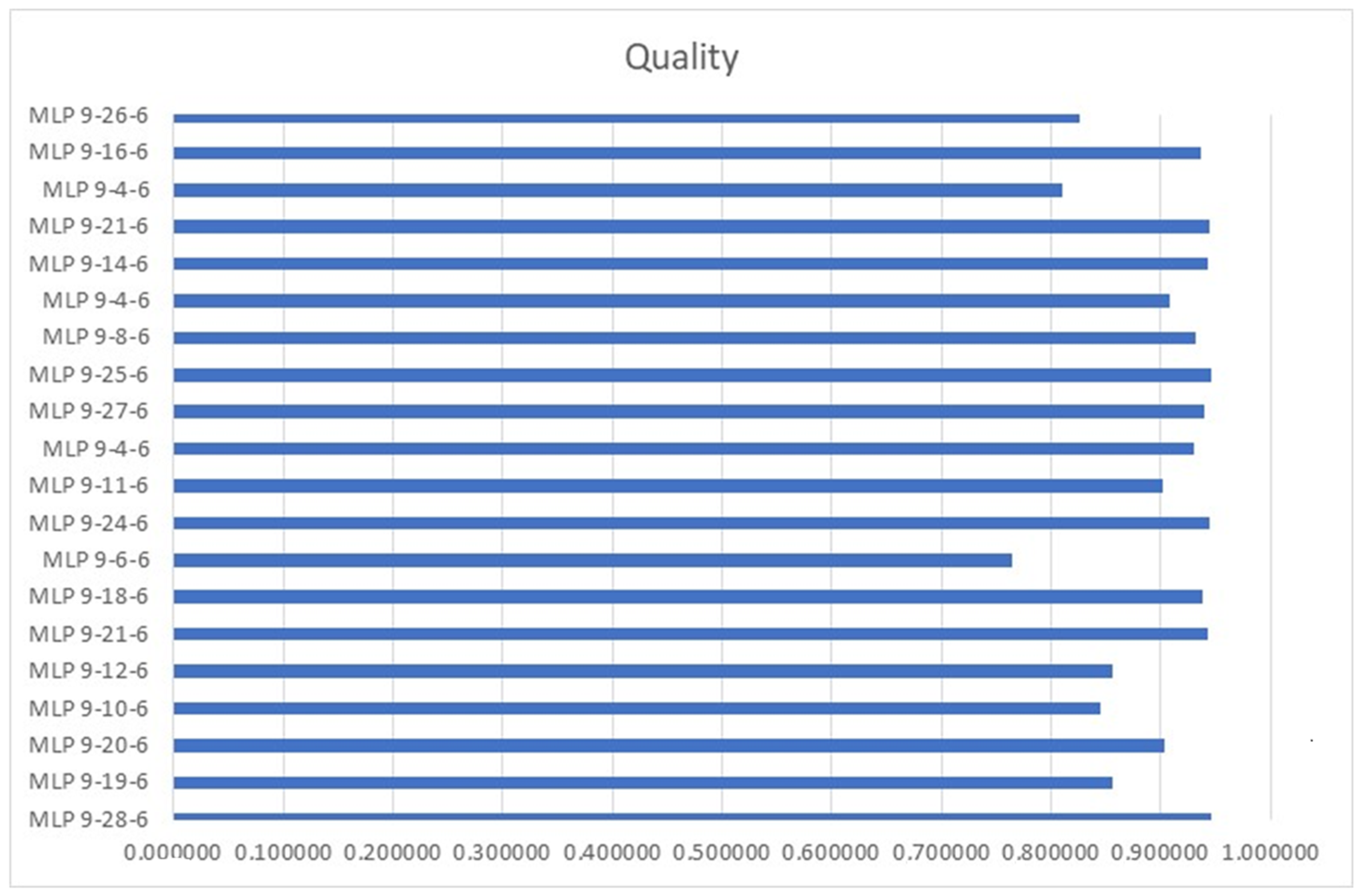
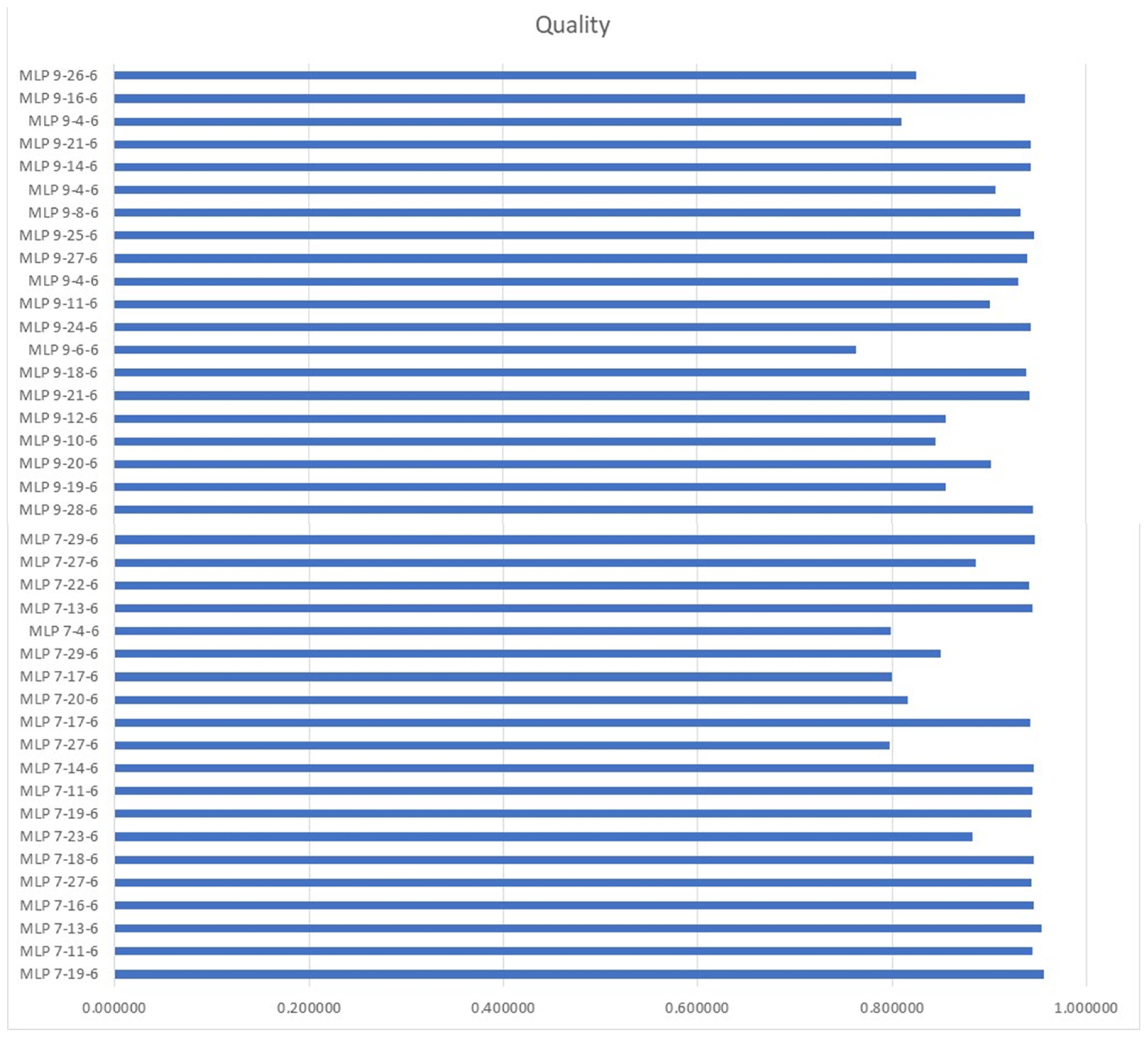
| Experiment No. | 1 | 2 | |
|---|---|---|---|
| Head temperature | Ht [°C] | 225 | 190 |
| Bed temperature | Bt [°C] | 60 | 21 |
| Layer | L [mm] | 0.2 | 0.3 |
| Printing speed | Ps [mm/s] | 50 | 30 |
| Nozzle diameter | Nd [mm] | 0.4 | 0.8 |
| Cooling | yes/no | yes | no |
| Experiment | Run | Head Temperature [°C] | Bed Temperature [°C] | Layer [mm] | Printing Speed [mm/s] | Nozzle Diameter [mm] | Cooling |
|---|---|---|---|---|---|---|---|
| 1 | 1 | 225 | 60 | 0.2 | 50 | 0.4 | yes |
| 2 | 190 | 60 | 0.2 | 50 | 0.4 | yes | |
| 3 | 225 | 21 | 0.2 | 50 | 0.4 | yes | |
| 4 | 225 | 60 | 0.3 | 50 | 0.4 | yes | |
| 5 | 225 | 60 | 0.2 | 30 | 0.4 | yes | |
| 6 | 225 | 60 | 0.2 | 50 | 0.8 | yes | |
| 7 | 225 | 60 | 0.2 | 50 | 0.4 | no | |
| 2 | 1 | 190 | 21 | 0.3 | 30 | 0.8 | no |
| 2 | 225 | 21 | 0.3 | 30 | 0.8 | no | |
| 3 | 190 | 60 | 0.3 | 30 | 0.8 | no | |
| 4 | 190 | 21 | 0.2 | 30 | 0.8 | no | |
| 5 | 190 | 21 | 0.3 | 50 | 0.8 | no | |
| 6 | 190 | 21 | 0.3 | 30 | 0.4 | no | |
| 7 | 190 | 21 | 0.3 | 30 | 0.8 | yes |
| Network | Quality Correlation Coefficient | Algorithm | Error Function | Activation (Hidden) | Activation (Output) |
|---|---|---|---|---|---|
| MLP 9-28-6 | 0.945697 | BFGS 140 | SOS | Logistic | Linear |
| MLP 9-19-6 | 0.855433 | BFGS 27 | SOS | Sinus | Logistic |
| MLP 9-20-6 | 0.902776 | BFGS 32 | SOS | Sinus | Exponent |
| MLP 9-10-6 | 0.845208 | BFGS 26 | SOS | Sinus | Exponent |
| MLP 9-12-6 | 0.855169 | BFGS 53 | SOS | Sinus | Tanh |
| MLP 9-21-6 | 0.942370 | BFGS 135 | SOS | Tanh | Tanh |
| MLP 9-18-6 | 0.938743 | BFGS 102 | SOS | Logistic | Tanh |
| MLP 9-6-6 | 0.764061 | BFGS 18 | SOS | Sinus | Tanh |
| MLP 9-24-6 | 0.943776 | BFGS 167 | SOS | Exponent | Tanh |
| MLP 9-11-6 | 0.901547 | BFGS 45 | SOS | Linear | Exponent |
| MLP 9-4-6 | 0.929888 | BFGS 62 | SOS | Exponent | Exponent |
| MLP 9-27-6 | 0.940146 | BFGS 91 | SOS | Logistic | Linear |
| MLP 9-25-6 | 0.946325 | BFGS 213 | SOS | Exponent | Linear |
| MLP 9-8-6 | 0.932218 | BFGS 44 | SOS | Exponent | Logistic |
| MLP 9-4-6 | 0.907379 | BFGS 110 | SOS | Tanh | Tanh |
| MLP 9-14-6 | 0.942824 | BFGS 125 | SOS | Tanh | Tanh |
| MLP 9-21-6 | 0.943772 | BFGS 147 | SOS | Exponent | Tanh |
| MLP 9-4-6 | 0.810172 | BFGS 111 | SOS | Linear | Tanh |
| MLP 9-16-6 | 0.937108 | BFGS 105 | SOS | Tanh | Tanh |
| MLP 9-26-6 | 0.825928 | BFGS 32 | SOS | Linear | Linear |
| Network | Quality Correlation Coefficient | Algorithm | Error Function | Activation (Hidden) | Activation (Output) |
|---|---|---|---|---|---|
| MLP 7-19-6 | 0.956329 | BFGS 176 | SOS | Tanh | Logistic |
| MLP 7-11-6 | 0.944358 | BFGS 84 | SOS | Logistic | Exponent |
| MLP 7-13-6 | 0.953633 | BFGS 226 | SOS | Logistic | Logistic |
| MLP 7-16-6 | 0.945675 | BFGS 199 | SOS | Exponent | Exponent |
| MLP 7-27-6 | 0.942761 | BFGS 272 | SOS | Exponent | Sinus |
| MLP 7-18-6 | 0.945685 | BFGS 78 | SOS | Tanh | Logistic |
| MLP 7-23-6 | 0.882231 | BFGS 25 | SOS | Sinus | Logistic |
| MLP 7-19-6 | 0.943589 | BFGS 88 | SOS | Exponent | Logistic |
| MLP 7-11-6 | 0.944691 | BFGS 135 | SOS | Exponent | Exponent |
| MLP 7-14-6 | 0.945054 | BFGS 279 | SOS | Exponent | Tanh |
| MLP 7-27-6 | 0.797824 | BFGS 14 | SOS | Liniowa | Tanh |
| MLP 7-17-6 | 0.942128 | BFGS 150 | SOS | Tanh | Linear |
| MLP 7-20-6 | 0.815488 | BFGS 19 | SOS | Linear | Linear |
| MLP 7-17-6 | 0.799536 | BFGS 31 | SOS | Linear | Tanh |
| MLP 7-29-6 | 0.849912 | BFGS 18 | SOS | Sinus | Linear |
| MLP 7-4-6 | 0.799030 | BFGS 40 | SOS | Liniowa | Tanh |
| MLP 7-13-6 | 0.944271 | BFGS 73 | SOS | Logistic | Exponent |
| MLP 7-22-6 | 0.940799 | BFGS 242 | SOS | Exponent | Sinus |
| MLP 7-27-6 | 0.885987 | BFGS 26 | SOS | Linear | Exponent |
| MLP 7-29-6 | 0.946352 | BFGS 233 | SOS | Tanh | Linear |
Disclaimer/Publisher’s Note: The statements, opinions and data contained in all publications are solely those of the individual author(s) and contributor(s) and not of MDPI and/or the editor(s). MDPI and/or the editor(s) disclaim responsibility for any injury to people or property resulting from any ideas, methods, instructions or products referred to in the content. |
© 2024 by the authors. Licensee MDPI, Basel, Switzerland. This article is an open access article distributed under the terms and conditions of the Creative Commons Attribution (CC BY) license (https://creativecommons.org/licenses/by/4.0/).
Share and Cite
Dostatni, E.; Osiński, F.; Mikołajewski, D.; Sapietová, A.; Rojek, I. Neural Networks for Prediction of 3D Printing Parameters for Reducing Particulate Matter Emissions and Enhancing Sustainability. Sustainability 2024, 16, 8616. https://doi.org/10.3390/su16198616
Dostatni E, Osiński F, Mikołajewski D, Sapietová A, Rojek I. Neural Networks for Prediction of 3D Printing Parameters for Reducing Particulate Matter Emissions and Enhancing Sustainability. Sustainability. 2024; 16(19):8616. https://doi.org/10.3390/su16198616
Chicago/Turabian StyleDostatni, Ewa, Filip Osiński, Dariusz Mikołajewski, Alžbeta Sapietová, and Izabela Rojek. 2024. "Neural Networks for Prediction of 3D Printing Parameters for Reducing Particulate Matter Emissions and Enhancing Sustainability" Sustainability 16, no. 19: 8616. https://doi.org/10.3390/su16198616
APA StyleDostatni, E., Osiński, F., Mikołajewski, D., Sapietová, A., & Rojek, I. (2024). Neural Networks for Prediction of 3D Printing Parameters for Reducing Particulate Matter Emissions and Enhancing Sustainability. Sustainability, 16(19), 8616. https://doi.org/10.3390/su16198616








